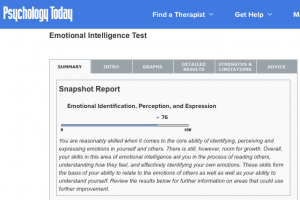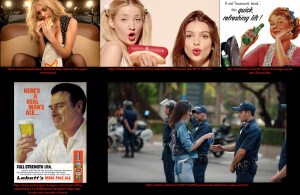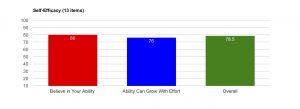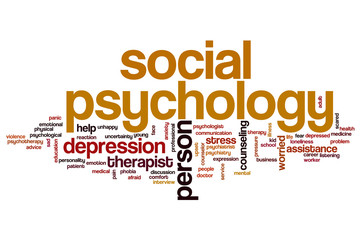Blog 10:
After rereading what I wrote in the first blog, I can see that this course ended up being quite a bit different than what I thought it would be – in a good way. I expected the information in this course to be very theoretical, but what I found instead is that much of what I learned in this course came in an applied manner. I definitely feel as though I have largely achieved the course objectives, especially in regards to understanding the factors that influence our liking for other individuals, and in how attitudes are formed & changed and relate to behavior. With those lessons learned, my attitude toward Social Psychology has changed in that I find it even more interesting than I thought I would. Initially, my interest was pretty high, but I can now say that it has proven to be one of my favorite courses thus far. I do not believe that I would change anything if I took the course over again, because I feel as though I have learned a lot and my grade is where I want it to be. Although, I suppose that if I were to hypothetically take this class again, I would do it in person instead of online, just to see if I would get anything different out of it.
Academically, I believe the biggest growth I have gotten out of this course, aside from the information, has come in my ability to write. Specifically, I am referring to writing in the first person. Most of the courses I have had so far did not require, or allow, writing in the first person. When this course first began, I felt a bit of hesitation with writing this way, but have since grown to be much more comfortable with it. In regards to a skill that I have gained from the class, I think I have learned how to be more self-aware. The assignments in this course encourages students to explore their own identity and behaviors, and I think that is a useful skill to have, especially as it relates to learning about psychology. I believe that the better I can apply these concepts to my own identity and behaviors, the better I can use them in a professional setting. This skill was developed, in part, due to much of the first person writing that I have done this semester.
In an effort to represent my academic growth through the course, I am including an image based on a keyword search of “expand your mind,” which is what I feel like I have accomplished here. I am moving forward from this class with a much better understanding of psychology, which is my ultimate goal.

http://www.abundanceunleashed.com/consciousness-and-energy-creates-the-nature-of-reality/
Blog 9:
In reviewing the contents of my e-Portfolio, I can quickly see that I have learned a wide variety of material throughout the semester. It is challenging to choose which lessons I have enjoyed the most, but if I had to pick the top three then I would say the information on advertising, specifically Jean Kilbourne’s Killing Us Softly video, the material involving emotional intelligence, and of the course the assignment on the connection between music and relationships. Each of these things gave me a lot to think about, and helped me better understand human behavior. The material on advertising reaffirmed some of my own thoughts on the impact of commercials, and it provided me with a much clearer understanding of how and why advertisements can be potentially dangerous. The information on emotional intelligence also really stood out, because I found that I was able to connect it to a some of the other material found on my e-Portfolio page. After I took the EQ test, I instantly connected the results to Assignment Takeaway 2, where I discussed my self-concept and self-presentation. I found that information important because it not only gave me a chance to better understand other individuals, it also gave me an opportunity to reflect on myself. Furthermore, the emotional intelligence and self-concept material applied to another course I am currently enrolled in: Lifespan Development. In one of the lessons in that course, we studied self-understanding as it relates to the development of children. I am quickly noticing that several parts of my psychology courses connect, but the self-concept/self-understanding material really stands out. As previously stated above, I have learned a wide variety of material this semester and I have enjoyed just about all of it. To help encapsulate the process of boiling down all the things I’ve learned this semester, and it how all connects, I am including a symbolic image of my brain connecting the dots in my head.

https://www.the-fulcrum.com/blog/connecting-dots-personalized-learning-business-outcomes/
Blog 8:
The article, Sexual Conflict: Uncovering the Mysteries of the Mating Battleground, by Nathan DeWall proved to be a very interesting read. One of the parts that stood out most to me was in regards to the three stages of the mating process where sexual conflict could be spotted. Each stage made a lot of sense in terms of how conflict can be spotted, with the first stage being especially familiar. The idea of people fibbing and using deception to advance one’s chances of having sex or securing nonsexual resources seems to be a very common theme. I believe that this stage really reflects one of the ways in which men upset women, in that men will deliberately deceive women during their pursuit for sex. According to the article, 71% of men admit to faking emotions in order to increase their chances of having sex. Men lying to women for sex is obviously problematic for a variety of reasons, and is probably one of the most common ways that men upset women because it is such a frequent event, as evidenced by the 71% statistic. On the the flip side, one of the ways in which women upset men is in regards to power struggle. While I do believe that this is bit of a cliché, I will still include it for the sake of the assignment. I use this example because it seems to be a common theme among men, where they become frustrated over feeling as though they have lost control of trivial things after being in a committed relationship. These things may include a change in frivolous spending habits, control of the radio or remote, and being asked to participate in things that they may not be interested in. I do not believe either example to be true for all men or women, but they do seem to be reoccurring themes in movies and television, as well as office talk or gossip. Speaking for myself personally as a male, there are no exclusive female behaviors or actions that upset me. With that said, below is an image from the internet to help illustrate a stereotypical view where a man and woman are upset with each other.

https://respect2agoddess.wordpress.com/2014/11/08/hot-topic-men-vs-women-why-we-cant-stop-arguing/
Blog 7:
The relationship between Self-Regulation and Emotional Intelligence is a very close one. To me, emotional intelligence refers to an individual’s ability to recognize and control emotions. As Linda Ferguson states in her video, Self Regulation and Emotional Intelligence, emotions are located on the inside, and can therefore be regulated. One common way for a person to control his or her emotions is by taking deep breathes. This technique creates a gap between one’s emotions and reactions. Taking a moment to breathe allows an opportunity for logic and reason to kick in.
To see how emotionally intelligent I was, I took 3 different online tests. The first one had 10 questions, and scored me 80 out of 200, describing me as below average. I was admittedly surprised at that score. The second test had 15 questions and scored me as a 55 out of 75, designating me as average (where above average started at 56). The third test was the most thorough, in that it had 146 questions. The questions ranged from personal tendencies to considering different scenarios. That test scored me as a 76 out of 100, and it is the one that I chose to use as my representative visual image. Overall, it seems that I have an average emotional intelligence, with room for improvement. I think the area where I could improve most is in regards to how I interact with others in less than favorable situations. For example, I know myself to be easily frustrated when driving in traffic. Instead of getting mad when someone aggressively cuts me off, I should just take a moment to breathe and just keep safely driving. This is something that I have realized about myself in the past, but I need to start practicing the breathing method, and perhaps explore some other calming techniques.

Blog 6:
Jean Kilbourne’s Killing Us Softly was an incredibly informative video, and it really put a lot of my own personal suspicions into better context. As mentioned in my previous blog, I find advertising to be incredibly frustrating. I feel like advertisements are always trying to steal my attention. Part of how they do that is by using music and sex. When a commercial comes on my television, it seems as though the music gets really loud in volume in order to get me to look at the screen, where I then see a scantily clad woman stuffing a cheeseburger in her mouth with a Hardees/Carl Jr. logo in the corner. Prior to watching this video, I was absolutely aware that ads distort, stereotype, and dehumanize women while manipulating people to buy their products. For me, those Hardees commercials are one of the most obvious examples that come to mind. Something that I did learn from the video is just how frequently these methods are used.
Kilbourne stated that the average American will watch over a years worth of advertising in his or her lifetime. The video is dated, so I would suspect that number to be much higher now. Seeing people, especially women, dehumanized so regularly has terribly negative effects on people and society. Seeing women objectified in media and advertising has clearly created a warped view of the female body and has influenced how women are treated. Here are five examples that show the different ways in which people are distorted, stereotyped, and dehumanized in advertising.

The first ad pictured is one of the more notorious Hardees commercials featuring Kate Upton. This is one of the ads that objectifies women. The second ad, which is for the Beats by Dre “Beats Pill,” is also one that objectifies women. The third ad stereotypes women, by showing a woman taking a break from cleaning the house and suggesting that women are the ones responsible for keeping a clean home. The 4th ad uses masculinity, implying that only a real man drinks the kind of beer that is being advertised. The 5th advertisement is a Pepsi ad featuring Kendall Jenner, wherein she hands a policeman a can of Pepsi during a protest. Even though this ad doesn’t pertain to differential gender representation, it does touch on another of Kilbourne’s points, when she mentions how advertisements also trivialize social issues. All of these ads are dehumanizing in their own way, but as Kilbourne’s video shows, recognizing these problems can help us see the negativity that these kinds of advertisements have on society.
Blog 5:
Advertising is definitely one of those things that really frustrates me. Commercials can be so loud and obnoxious. It is quite obvious that they are trying to grab my attention. I tend to change the channel or mute the television when a commercial comes on my TV. Of course, some advertisements are informative, and some are even kind of funny. Regardless of how one feels about commercials, it is important to understand the difference between an advertisement that is credible versus one that is not. It is also helpful to have the ability to recognize the different methods that advertisements use to persuade us. Some use fear, while others use attractiveness to change our attitudes. To help understand the difference between credible and non credible sources, I have chosen three different print advertisements. The first one is credible, the second one is not credible, and the third ad is an example of an attractive source.
The credible ad, pictured below, is an advertisement for Sensodyne toothpaste. The major factor it relies on to persuade consumers is expertise. The image states that “8 Out of 10 Dentists Recommend Sensodyne,” right next to a picture of “practicing dentist” Dr. Gauri Mohile. Another factor the ad uses is trustworthiness. Most people tend to trust their regular dentist, and probably dentists in general. Factors such as expertise and trustworthiness play a major part in whether or not an ad is perceived as credible.
Credible Source.

https://www.kulzy.com/work/131803/sensodyne/newspaper-magazine-book/helps-restore-natural-whitness/
The not credible ad, pictured below, is an advertisement for Subway. It features Subway spokesman Jared Fogle, and alludes to his story where he allegedly lost weight eating Subway sandwiches. This source is not credible because they use an exaggerated testimonial from an individual who is neither a doctor nor a dietician. Furthermore, Subway has a serious financial stake in the situation, and will say what they need to say in order to get people to buy their sandwiches.
Not Credible Source

http://uofh1304atten.blogspot.com/2011/04/thesis-this-ad-claims-that-subway-is-so.html
The third advertisement represents an attractive source. It is an advertisement for Gamefly featuring professional basketball player Blake Griffin. Advertisements sometimes employ people who are famous or physically attractive in order to persuade consumers. It is extremely effective in most cases, which is evidenced by the fact that most popular brands rely on attractive sources to sell products. Advertisers use this tactic, because it can potentially make people feel like they will also be attractive if they purchase the product being advertised. It is also true that people who are regarded as attractive are often perceived as being more likable, and people are more likely to be persuaded by someone they like.
Attractive Source

https://mattbeardphoto.wordpress.com/2014/03/05/blake-griffin-for-gamefly/
Blog 4:
In the three years I have been back in college, I can only recall 2 or 3 times that I have received a 100 on a test. Even in high school, I don’t remember scoring a 100. So once I completed the first exam in Social Psychology, I was quite surprised to see that I aced the test. There were a couple of questions that I was not sure of, but I tried to apply certain techniques such as omitting the answers that I knew were wrong and looking for cues that might help me answer correctly. Of course, the biggest thing that helped me was studying and reviewing the information. I went back and looked at all of the powerpoint presentations a couple of days before the exam, and I reviewed each of them by taking notes. Writing things down often helps me memorize definitions and concepts. I used the “Test 1 Review” document as a guide, which really helped me narrow my focus on the information that I needed to know for the exam. Reviewing the study guide was something that was mentioned in Study Tips document, as was freeing myself from distractions. I made sure to take the test while I was at home alone, so that I could take the exam in complete silence. These are strategies that I will continue to regularly use, especially because they proved to be so beneficial this time around. I have also had the benefit of learning some of these concepts in my other courses. Terms like self-efficacy, self-esteem, collectivist societies, informed consent, and survey methods are all topics found in some of the other courses I am currently enrolled in, or have already taken. While the instructions for this blog ask to review the questions I answered incorrectly, I was not able to do that because of my score. I did, however, review some of the questions that I was not sure about. This included the questions about affective forecasting and the correspondence bias.
For this blog, I am choosing an image of some of the notes I made while I was studying for the exam. Again, note taking is something that has always helped me to succeed and plays a major role in how I study.

Blog 3:
The connection between music and relationships is undeniable. I think a huge reason for that connection is because people often use music as a form of identification. A person’s favorite artists, albums and songs can really provide insight into some of the other things he or she might like. My wife and I have similar tastes in music. Our first unofficial date was a Kings of Leon concert at the Ted Constant Convocation Center. She and I shared similar values and ideals early on, but as we have grown together our principles and morals are more alike now then they were when we first started dating. Interestingly, our tastes in music have grown more in sync with each other as well. The same can be said of my friends. Growing up, most of my friends liked all of the same music as I did. I actually met one of my best friends because we were the only two kids in class that liked punk music.
With that said, I don’t believe that the music connection holds true for everyone. My mother is deaf, as are all of her closest friends. Music is not a priority for her, though she does like music when she can feel the vibration of it. I think that there are other ways to connect to people, with music having little to do with it. My grandparents, for example, have very different tastes in music. My grandfather has zero interest in music, while my grandmother is quite keen on Elvis and oldies in general. They do, however, really connect on their religious values, as well as their hobbies.
For me personally, music is a huge part of my life. I have been playing music for over 15 years, and I make playlists almost everyday to fit my feelings and mood. I believe that music can accurately reflect an individual’s personality because music is very behavioral. Singing, dancing, and tapping a pattern are all physical acts that can reflect different feelings. To show my feelings, I have chosen six songs to represent the people who are closest to me.
For my wife, I have chosen Dusty Springfield – Only Want to be With You. This was our wedding song, and we still listen to it on a regular basis.
I chose Beastie Boys – Rhymin’ and Stealin’ for my mom because it’s a song that she always had me play when a lot of her friends were visiting. It always made me laugh because it’s such a goofy song, but my mom and her friends always liked the beat. They usually played music like this at their parties, which I always referred to as Deaf Jams, because the music was usually 80’s hip-hop from Def Jam records.
In the first paragraph, I mention meeting one of my best friends over our shared love of punk music. So for Nic, I chose NOFX – All Outta Angst. I have known him for 15 years and I have never seen him mad, not even when we were teenagers. This song is about being out of things to be angry at, and therefore was his theme song. It also reminds me of my youth.
The other person closest to me is not a person at all, but is actually a dog. My dog Mario is truly mine and my wife’s best friend. When we have to leave him at home to go out of town, or even just out to dinner, we often play Harry Nilsson – The Puppy Song to remind us of him.
The song I chose for myself is one that I listen to on a regular basis, The Cramps – The Green Door. I love the way this song sounds, and I love the lyrics. In it, the singer is describing how all he wants to do to is be on the other side of the “green door,” where it sounds like everyone else is having a really great time, while he is stuck outside left wondering why everyone else gets to have fun but him. I think everyone probably feels that way at some point in the week.
The sixth song I chose represents my outlook on life. Funkadelic – Biological Speculation is a really great song that reminds listeners that we’re just a “biological speculation, sitting here vibrating and we don’t know what we’re vibrating about.” It really reflects the questions that I have about life and the universe, like “why are we here” and “are we doing this right?”

For this blog, I chose an image of my dog, Mario. I chose it because I mentioned him in the post, and this image in particular shows him looking pretty punk rock thanks to his mohawk and facial expression.
Blog 2:
When I graduated from high school back in 2006, I was not a fan of school. I found it to be a very uncomfortable place, and I felt like I seldom learned anything interesting or important. I believe that a major reason for feeling this way was due to a lack of confidence. I had very low self-efficacy, to the point that it hurt my desire to learn. In the years following graduation, I developed a healthy level of confidence by being successful at work and learning how to become a task oriented individual. In 2015, I went back to school and completed the Social Sciences program at Tidewater Community College with a 3.8 GPA. I was surprised to find myself consistently enjoying the material that I was studying, leading me to realize how good it feels to learn. Now, as a junior at Old Dominion University enrolled in the Psychology program, my self-efficacy is fairly high. I am a student who studies hard and tries to stay on top of tasks. I make sure to prioritize and plan ahead in order to give myself plenty of time to complete assignments.
I believe the biggest factor that has influenced my self-efficacy would be the experiences I had after graduating from high school. I was fortunate enough to find a job that I was good at, which eventually led me to appreciate the idea of being successful. To increase my confidence levels from here, I plan to surround myself with individuals who have already experienced a certain level of success so that I can incorporate some of their better qualities. I can do this by studying with other students who are further along than I am, or by shadowing upper level management at work.
I believe that my self-efficacy results don’t fully speak for my task accomplishments. I always come away having learned something from every assignment, which usually shows up in my grades and in my ability to talk about what I’ve learned with someone else. According to my results, my belief in my ability is at an 80, while the belief that ability can grow with effort is at a 76. I think that these results are much higher than they would have been when I was younger, but I don’t think that they are high enough to match my current level of success at school.
SELF-EFFICACY SURVEY RESULTS FOR LUKE EDWARDS

I chose my survey results as the image to accompany this blog, because I want to look back on it after the semester ends. I also want to look back on it a second time, once I complete the psychology program. Each time I return, I would like to test myself to see if the factors that I discussed will increase my self-efficacy.
Blog 1:
The course objectives for Social Psychology will definitely help me in the future as I pursue a Bachelor’s in Psychology, with a minor in Addiction Treatment Prevention. Understanding how attitudes are formed and changed, and how each relates to behavior will be critical to my career path, which will most likely involve social work. Furthermore, understanding the procedures social psychologists use to test hypotheses will be applicable to my other classes. I expect that at some point I will have to test theories of my own. Having a complete understanding of how professionals make accurate conclusions will hopefully increase my chances of success. My other expectations include expanding my vocabulary in the subject of psychology, and developing a more well rounded view of how individual behavior is affected by society. By acquiring this knowledge, I hope to gain the ability to apply these lessons in real life. It is my hope that everything I learn here can be used as a tool when I start my career in the human services field. In order to ensure my success, I plan to study hard and spend a great deal of time with the material. I will utilize all of the resources that are available to me through the university, and through ODU’s psychology program. I am already looking forward to the next set of modules, and anticipate that I will be learning a lot as the year progresses.
I chose the image below because it emphasizes the course subject, and lists several vocabulary terms that I expect to learn throughout the semester.

https://stock.adobe.com/ee/search?ca=0&filters%5Bcontent_type%3Aphoto%5D=1&filters%5Bcontent_type%3Aillustration%5D=1&filters%5Bcontent_type%3Azip_vector%5D=1&filters%5Bcontent_type%3Avideo%5D=1&filters%5Bcontent_type%3Atemplate%5D=1&filters%5Bcontent_type%3A3d%5D=1&filters%5Bcontent_type%3Aimage%5D=1&filters%5Binclude_stock_enterprise%5D=0&filters%5Bis_editorial%5D=0&k=social+psychology&order=relevance&safe_search=1&similar_content_id=138981866&search_page=1&acp=&aco=social+psychology&limit=100&native_visual_search=&get_facets=0&asset_id=138981866